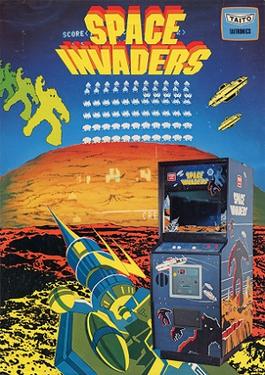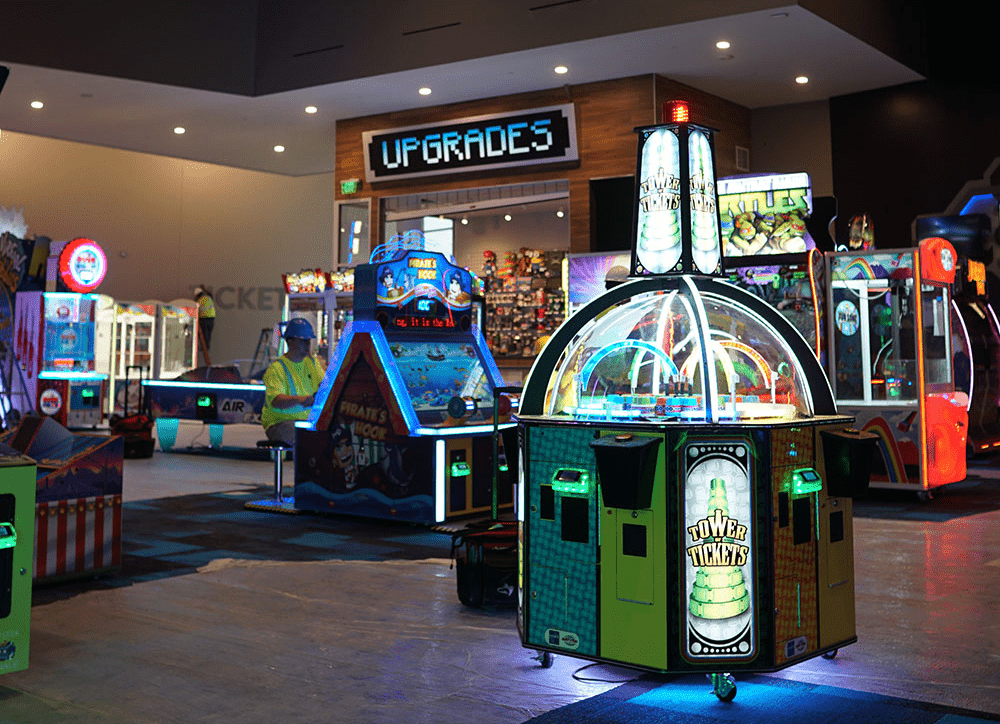History of Coin-Operated Arcade Games
7 Minute Read
Video games have gone from a niche hobby to a massive industry; there are dozens of enormous game releases each year, and the eSports scene has had unprecedented growth in recent years. Here is a short history of arcade games to learn a bit more.
For younger generations, it might seem like game consoles have always been a fact of life; anyone under 25 probably grew up with a PlayStation or Xbox in their house.
The truth is that the ubiquity of consoles is relatively new.
Long before the home console, there was the arcade. So, to understand the history of gaming, you need to know the history of arcade games.
Coin-operated arcade games drove the popularity of video games for decades. Even after the Nintendo Entertainment System was released in 1983–a significant turning point for console gaming–arcade cabinets remained a driving force in the gaming industry.
It’s easy to see why: a video game console is expensive, and that’s before buying the games to go with it. On the other hand, an arcade cabinet offers the same amount of fun for a handful of quarters.
We’re getting ahead of ourselves, though. Read on to learn about the history of arcades, starting from the earliest arcade games.
Humble Beginnings
What do you picture when you hear the word ‘arcade?’ Whether you remember the dimly lit arcades of the ’90s or modern chains like Dave & Busters, you’re probably picturing a room with many cabinets and games.
You might not realize that the familiar arcade trappings we all know and love arose from a much different kind of gathering place. Before there were arcades, there were amusement halls.
An amusement hall was similar to an arcade: it was a place where people could get together, spend money on coin-operated machines, and have a good time–but they were around before arcade games.
So, what kind of entertainment did amusement halls offer? An amusement hall had two main draws: slot machines and pinball.
Due to the gambling laws of the time, slot machines didn’t last long in most amusement halls. Pinball machines, on the other hand, became massively popular.

The history of pinball is a critical element in the growth of arcades. They were some of the most famous early coin-operated machines, paving the way for arcade cabinets. They remain a fixture of many arcades today.
From Spacewar! to Space Invaders
In 1971, the world tilted on its axis. Not literally, of course, but something seismic shifted in the realm of entertainment. That year, Nolan Bushnell and Ted Dabney, the visionary minds behind Atari, unleashed Computer Space, the first-ever arcade video game. Imagine a clunky cabinet spitting out pixelated rockets soaring through a starry void, battling flying saucers with reckless abandon – that was the dawn of a revolution.
Although the first arcade game wasn’t built until 1971, we must return to 1962 to get the complete picture of arcade history. That was the year Steve Russell created one of the first video games: Spacewar!
It was a simple game by modern standards, featuring two spaceships that could fire missiles at each other. At the time, though, it was a breakthrough.
Spacewar! Inspired two students at Stanford University, Bill Pitts and Hugh Tuck, to create Galaxy Game, a version of Spacewar! that was coin-operated and ran on a computer housed in a wooden console.
At the same time, Nolan Bushnell and Ted Dabney worked with Syzygy Engineering on another coin-operated version of Spacewar! Called Computer Space. Computer Space would become the first commercial arcade game.
The following year, Atari released Pong, which was much more successful than Computer Space and brought the idea of arcade gaming to a broader audience. These were humble beginnings that sparked the video game revolution. From Computer Space’s groundbreaking tech to Pong’s addictive simplicity, Atari laid the foundation for an industry that would captivate billions and leave an indelible mark on pop culture. So, the next time you find yourself glued to a screen, battling aliens or racing virtual cars, remember: it all started with a rocket, a paddle, and two visionary minds who dared to dream in pixels.
Following Pong’s success, more game companies began developing arcade games. More and more titles would hit the market throughout the ’70s, with racing games being the most popular.

Then, in 1978, Taito released Space Invaders, which changed arcades forever. Space Invaders was a smash hit, creating the shoot-’em-up genre and ushering in what would be known as the golden age of arcade games.
The Arcade Golden Age
As the ’70s closed, arcades experienced their biggest boom yet, becoming major fixtures throughout the ’80s. You know how big arcades were if you grew up in that decade (or watched Stranger Things).
While Space Invaders kicked off the arcade craze, it was joined by another significant release: Atari’s Asteroids, which became the company’s best-selling arcade game.
In 1980–a year after Asteroids and two years after Space Invaders–Pac-Man arrived. Soon, Pac-Man fever swept the nation, making it clear that the ’80s would be the decade of the arcade.
Developed by Namco and published in America by Midway (two companies that would become arcade juggernauts), Pac-Man revolutionized arcade games in several essential ways.
Pac-Man was the first mascot character in gaming, hitting the scene years before characters like Mario and Sonic. It also featured some of the earliest video game cutscenes.
The game was one of the first to appeal to both men and women: the game’s creator, Toru Iwatani, wanted to create a game that wasn’t based on violence or sports in the hopes that such a game would get women into arcades.
Evolving Arcade Playstyles
Pac-Man introduced a unique game genre into arcades: the maze chase. This was very different from the shooting and racing games that preceded it, and as the Golden Age wore on, many more new genres would arrive.
One great example was Donkey Kong, which introduced many people to the platformer genre, a popular game style today. Like Pac-Man, Donkey Kong was an arcade titan with an enormous legacy.
Konami released Scramble in 1981, which is considered the first side-scrolling shooter. This was hugely influential, and side-scrolling shooters became a staple of gaming until the advent of three-dimensional consoles.
The journey brought digitized sprites to the arcade in 1983; that same year, Cinematronics released Dragon’s Lair, the first game to use cel-animated video (with art by renowned animator Don Bluth).
Puzzle platformers like Bubble Bobble, adventure games like Gauntlet, beat ’em-ups like Double Dragon, and more were released throughout the ’80s.
At the same time, pre-existing game genres were continually refined throughout the decade.
Namco’s Pole Position, from 1982, was not only one of the most popular racing games ever, but it also introduced 16-bit graphics to the arcade. Finally, in 1981, Defender introduced more complex control schemes to the world.
Street Fighter Enters the Fray
As the ’80s drew to a close, so did the golden age of arcade games. That doesn’t mean arcades disappeared, though–far from it. The early ’90s saw the release of a game that rocked the arcade world.
In 1991, Capcom released Street Fighter II, a game many still consider the pinnacle of the fighting game genre.
Fighting games existed before Street Fighter II, but none had ignited the competitive scene as this release did. It changed everything by featuring a six-button control scheme, a wider variety of special moves, and more.
During the golden age of arcade games, competitions over who could get the high score in games like Pac-Man. As Street Fighter’s popularity grew, competition in the arcade space became more direct.
Street Fighter II’s tight controls, deep strategy, and two-player versus mode made it the perfect game for head-to-head skill tests.
This led to the development of a vibrant fighting game community that persists today. Of course, the runaway success of Street Fighter II led to a boom in fighting game development. As a result, several new fighting franchises emerged, including Tekken and Mortal Kombat.
Arcade Hero: Meet Eugene Jarvis, Mastermind of Defender and Robotron
In the golden age of arcades, when quarters fueled pixelated adventures and joystick blisters were badges of honor, a certain name stood out from the crowd: Eugene Jarvis. This visionary isn’t just another game designer; he is an arcade alchemist, conjuring up classics that ignited imaginations and redefined the genre.
Jarvis’ early days were spent tinkering with Atari pinballs, honing his skills before unleashing his creative fury on the world of video games. In the early 1980s, he struck gold with Defender, an exhilarating shooter where you soared through a starry sky, blasting alien invaders and rescuing kidnapped humans. The dual-joystick controls, innovative scoring system, and addictive gameplay made it an instant phenomenon, propelling Jarvis to arcade legend status.
But Jarvis wasn’t content with one masterpiece. He followed up Defender with Robotron: 2084, a dystopian robo-rampage that pushed the boundaries of arcade action. With its frenetic twin-stick controls, waves of relentless enemies, and iconic “human error” message, Robotron became a cult classic, testing reflexes and challenging players to new skill levels.
Beyond these iconic titles, Jarvis’ influence reaches far and wide. He co-founded Vid Kidz, an early educational games developer, showcasing his commitment to using games for more than just entertainment. Later, in the 90s, he brought his magic touch to the driving genre with the Cruis’n series, putting players behind the wheel of virtual hot rods and redefining arcade racing experiences.
Today, Jarvis is an active force in the industry, leading his own development studio, Raw Thrills Inc, which launches new hit titles yearly. His legacy, however, is etched in the annals of arcade history. From the frantic dogfights of Defender to the neon-drenched streets of Cruis’n, Jarvis’ games are more than just pixels and circuits; they’re testaments to the power of imagination, innovation, and pure, unadulterated fun.
The Arcades of Today
While the fighting game craze helped arcades persist through the ’90s, their popularity steadily declined. By the early 2000s, game consoles were more commonplace, eliminating the need for arcades.
In addition, players were interested in longer narratives and more complex gameplay, which arcade games aren’t designed to provide. Finally, the rise of online play services like Xbox Live also contributed to the decline of arcades.
Arcades found a way to bounce back; they expanded their options. Many arcades are now part of more extensive Family Entertainment Center experiences, offering various activities, food, drinks, games, and redemption counters.

Today, massively successful restaurant chains incorporate arcade games into their experiences. They offer families a place to get a good meal and entertainment.
Arcades are also experiencing a resurgence due to nostalgia. Kids who grew up in the ’80s and ’90s have treasured memories of going to the arcade, and they’re opening their own arcades to cater to their peers.
Since many of these arcades are aimed at adult audiences who grew up on arcade games, they also offer alcohol, leading to the term ‘barcade.’
Barcades nationwide offers classic arcade titles and brand-new games that preserve arcade traditions. However, the main factor in the growth has been Family Entertainment Centers, which continue to evolve to include miniature golf, climbing walls, laser tag, VR, batting cages, ropes courses, and video games.
The current landscape of video arcade game manufacturers includes a robust lineup of companies, including Raw Thrills, LAI Games, Baytek Entertainment, ICE Games, and more.
Remembering the History of Arcade Games
Although arcades have evolved into Family Entertainments Centers, classic arcade games are still fonded. Titles like Donkey Kong and Mortal Kombat are revered for their impact on the industry.
It’s impossible to overstate how arcade games helped gaming grow—you can’t discuss the rise of video games without first discussing the history of arcade games.
Sign up for our newsletter to be the first to hear about new releases, product promotions, updates, and more!
